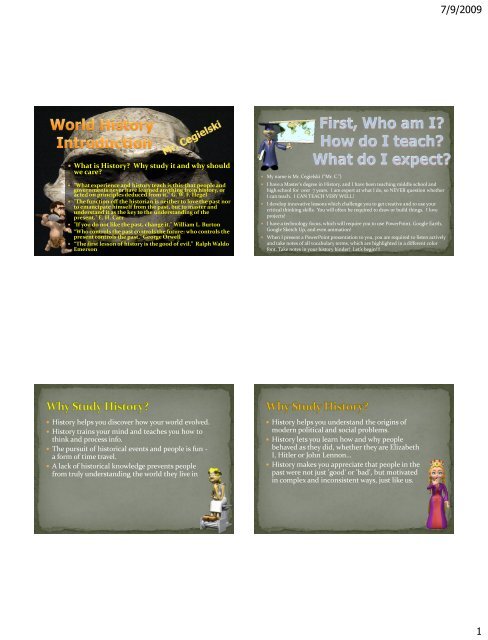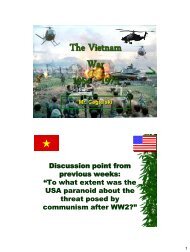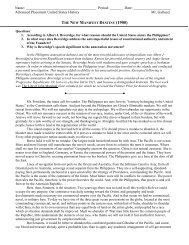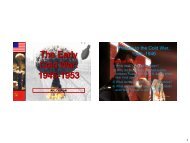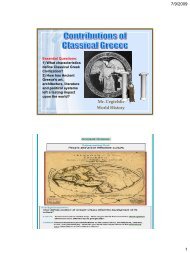Download File - Mr. Schuhmann's Social Studies Class
Download File - Mr. Schuhmann's Social Studies Class
Download File - Mr. Schuhmann's Social Studies Class
Create successful ePaper yourself
Turn your PDF publications into a flip-book with our unique Google optimized e-Paper software.
7/9/2009• What is History? Why study it and why shouldwe care?• "What experience and history teach is this-that people andgovernments never have learned anything from history, oracted on principles deduced from it." G. W. F. Hegel• "The function off the historian is neither to love the past norto emancipate himself from the past, but to master andunderstand it as the key to the understanding of thepresent." E. H. Carr• "If you do not like the past, change it." William L. Burton• “Who controls the past controls the future: who controls thepresent controls the past.” George Orwell• “The first lesson of history is the good of evil.” Ralph WaldoEmerson• My name is <strong>Mr</strong>. Cegielski (“<strong>Mr</strong>. C.”)• I have a Master’s degree in History, and I have been teaching middle school andhigh school for over 7 years. I am expert at what I do, so NEVER question whetherI can teach. I CAN TEACH VERY WELL!• I develop innovative lessons which challenge you to get creative and to use yourcritical thinking skills. You will often be required to draw or build things. I loveprojects!• I have a technology focus, which will require you to use PowerPoint, Google Earth,Google Sketch Up, and even animation!• When I present a PowerPoint presentation to you, you are required to listen activelyand take notes of all vocabulary terms, which are highlighted in a different colorfont. Take notes in your history binder! Let’s begin!!!• History helps you discover how your world evolved.• History trains your mind and teaches you how tothink and process info.• The pursuit of historical events and people is fun -a form of time travel.• A lack of historical knowledge prevents peoplefrom truly understanding the world they live in• History helps you understand the origins ofmodern political and social problems.• History lets you learn how and why peoplebehaved as they did, whether they are ElizabethI, Hitler or John Lennon...• History makes you appreciate that people in thepast were not just 'good' or 'bad', but motivatedin complex and inconsistent ways, just like us.1
7/9/2009• History helps you make sense of most other subjects.• History provides you with the skills employers arelooking for.• History gives you back your past.• Without an understanding of the past, the presentdoesn't make much sense"Those who cannotremember the pastare condemnedto repeat it."What do you think this statement means?Do you agree with it? Why/not?Edward Norton•Famous actor•studied History at YaleMira Sorvino•Famous actress•studied History at Harvard2
7/9/2009Chris Martin•Band: Coldplay•Stuied UCLSting•Famous musician•History teacher• History is the study of past humanevents and activities.• Anthropology- the study of humanbeings, their distribution,origins, classification, cultures, etc.• Archaeology- the study of material remains ofpeople, called artifacts, such as tools and weapons, todetermine what their lives were like• Geology- the study of the planet earth- itshistory as it is recorded in itself ( its rocks, rockformations, etc.)• Physical Anthropologists- study,specifically, the physical remains ofpeople (bones, etc.) to determine howthey looked.3
7/9/2009• Directions:• 1) Find all 13 words in the word search.• 2) Using all 13 words, write a paragraph of 100 words,answering the question “What is History?”•Scientist- A learnedinvestigator who uses thescientific method of study:theory & investigationand/or experimentation &collection of data= scientificconclusion.I. The earth is approximately5 billion years old.4
7/9/2009• The first living things, one-celled waterdwelling plants/animals first appearedapproximately 4 billion years ago.• A. They advanced to multi-celled creatures• B. Amphibians-- creatures that can live onland and in water, like frogs, brought creaturesonto land.5
7/9/2009• Evolution – The theory that all living thingschange, or evolve, through time in order to adapt totheir environments.• The scientist Charles Darwin developed the theoryof evolution during the 1800’s. He argued that onlythe strongest , most well-adapted organisms willsurvive while others will go extinct, or die out.• Organisms change by developing mutations.Mutations that prove successful remain.• According to scientists, humans and primatesemerged from a common ancestor. Through time,humans evolved by gaining the ability to walkupright as well as bigger brains.III. Hominids - "Two- legged primates"first appeared approximately 4million years ago.• First hominid species was called Australopithecusafarensis, which lived at least 4 million years ago.• Discovered by a scientist named Don Johanson inHadar, Ethiopia.• The skeleton was named “Lucy.” Lucy was onlyabout 3 feet, 8 inches tall. Males were somewhattaller and twice as robust.Pre-human hominids called HomoErectus used fire and made tools.They lived approximately 2 millionyears ago.6
7/9/2009• B. Homo Sapiens, true humans, firstappeared approximately 100,000 yearsago.•1. Neanderthal- died out•2.Cro-Magnon- our ancestors.7
7/9/2009Watch closely; Your assignment follows!• Directions: You will watch the documentary film“Becoming Human” at becominghuman.org. Your jobis to think like a paleontologist, a scientist who studiesthe remains of ancient humans in order to determinehow they looked and lived.• Do the following: Watch the film. Choose fourhominid species and create a four-column chart thatcompares the three species in relation to age, diet,range, and other information. Include sketches of theskull and how you think the hominid looked. (Thehominid profile section of the documentary will helpyou here.)8
7/9/2009• Paleolithic era (Old Stone Age)• 2 million B.C. – 8,000 B.C.• Mesolithic (Middle Stone Age)• 8,000 B.C – 6,000 B.C.• Neolithic (New Stone Age)• 6,000 B.C – 3,000 B.C.• 1. tools andweapons of stoneand bone• 2. used fire• 3. music and art• 4. traded• 5. language• 6. religion1. stored food and water in pottery jars2. bow and arrow3. boats, nets, spears and fishhooks4. domesticated dogs• 1. agriculture, crops, and livestock• 2. permanent settlements• 3. specialization of labor• 4. irrigation• 5. weaving• 6. government• 7. metal working• 8. writing9
7/9/2009• I. Tin and Copper, melted together in theproper amounts make bronze.• C. Metallurgy, the making and shaping ofmetal, was "born."• A. 3500 B.C. in the MiddleEast1800 B.C. in China1100 A.D. in the Americas• B. Bronze is a stronger metal thancopper. Bronze plows could bemade from it.• 1. Irrigation ditches• 2. Larger cultivated areas10
7/9/2009• II. Other important inventions of thisperiod included:• A. The sailboat• B. The potter's wheel11
7/9/2009• Complete sentences please:• 1) Which species of humans invented fire?• 2) List five of seven characteristics of civilization?• 3) Explain 3 advantages of establishing a civilization along a rivervalley.• 4) Name the three different eras of the Stone Age.• 5) What was the earliest species of human beings we studied?• 6) What does an archaeologist do?• 7) Define history.• 8) Explain the theory of evolution.• 9) Name a civilization which developed between the Tigris andEuphrates river.• 10) Lucy was part of which hominid species? Describe some of herphysical characteristics.• 11) How are science and history alike? Unalike?• 12) Name our direct ancestor.• 13) Bonus: Spell my last name correctly!12


